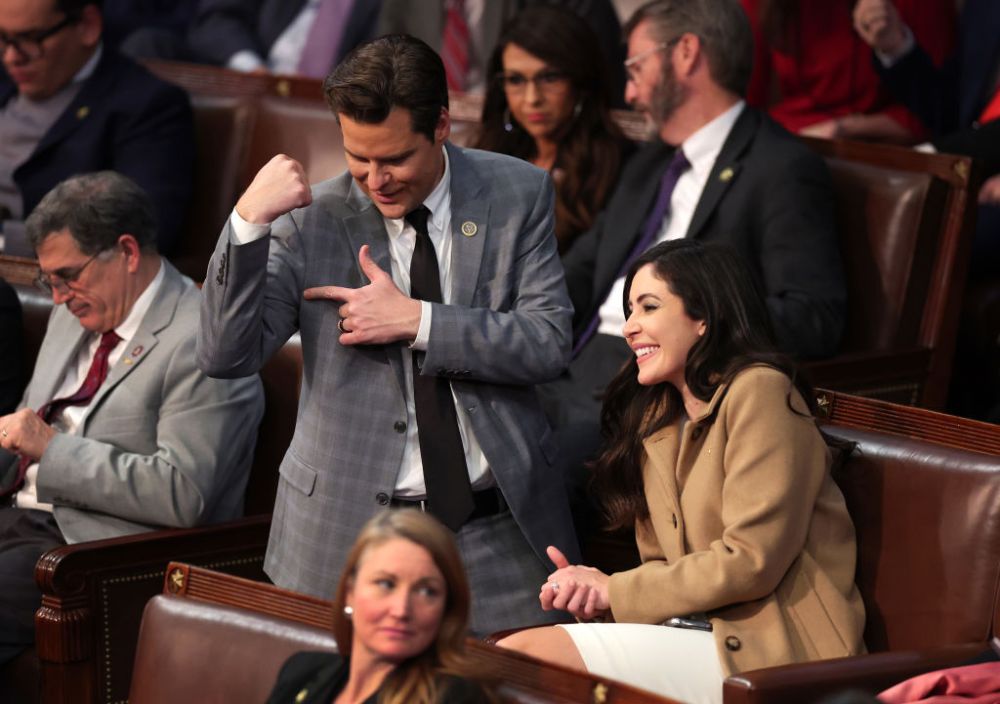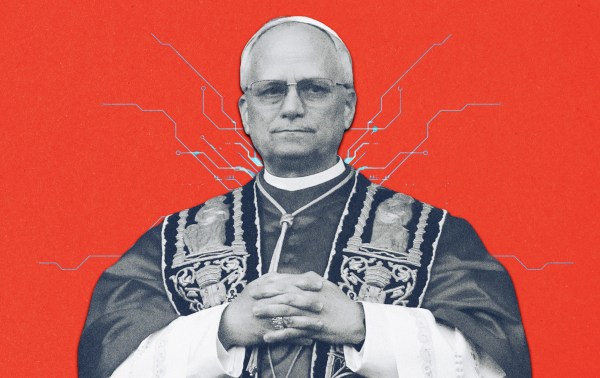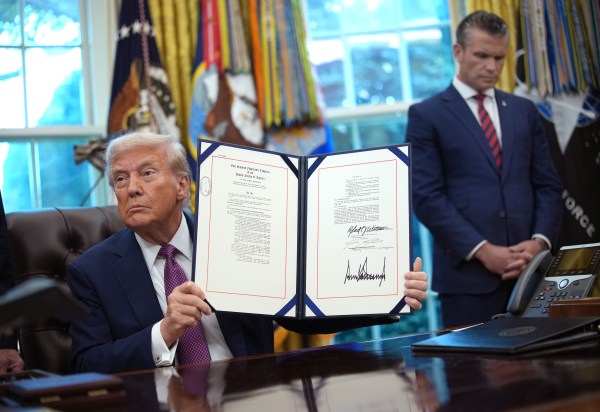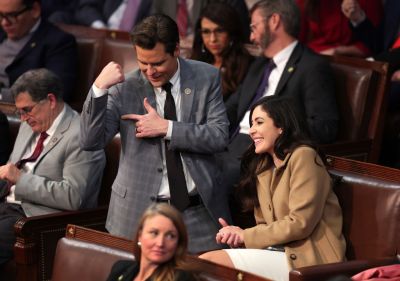Three opinions about the week that was are shared all but universally.
One: The fact that it took four days for the GOP majority to elect a speaker portends an era of historic, potentially frightening dysfunction. The first vote of the term is the easiest vote the House takes, it’s often said. If it’s all downhill from here, hoo boy.
Two: Kevin McCarthy has a preternatural tolerance for humiliation in pursuit of power, impressive even by the standards of careerist politicians. In the span of two years and two days, he went from cursing out a man who had incited a mob into almost murdering him to thanking that man for helping him get the gavel. For those who’ve read Madame Bovary, watching him win in the end felt like Monsieur Homais being awarded the Legion of Honor. One’s stomach churns with contempt for a culture that rewards such hollow men.
Three: C-SPAN’s coverage was awesome!
Vice has a nice explainer on how that awesomeness was achieved. C-SPAN has covered the House chamber for decades, but regular viewers were struck by how its access seemed to expand last week. Typically the only shots you see of the chamber are wide angles with the rostrum at the center and narrow shots of whichever member happens to be speaking on the floor. But that’s not because C-SPAN is uncreative about where it places its cameras; it’s because C-SPAN doesn’t control the cameras. The House Recording Studio, an arm of the House itself, does. C-SPAN simply airs the footage.
It’s the HRS that insists on limited camera angles, ignoring perennial requests from C-SPAN to take over coverage of the proceedings. The result is the static humdrum “C-SPAN format” for House operations with which we’re all familiar—during normal business.
There are, however, a few special events of unusual pageantry at which C-SPAN is allowed to bring in its own equipment and serve as the “pool” camera for the rest of the media. One is the State of the Union, where the audience’s reaction to different parts of the president’s speech is of news interest. Another is the election of the speaker on the first day of the new term. Every two years, for a few hours on January 3, C-SPAN gets to point its own lenses at members of the House as they go about the pro forma work of handing the majority leader the gavel.
The wrinkle this year was that that work ended up not being pro forma. Hours turned into days. Viewers who don’t typically see representatives huddle, kibitz, bicker, and deal as they go about making the proverbial sausage got to watch it for the better part of a week. What they saw, among other things, were intriguing confabs between the sworn enemies of the far left and far right.
There were plot twists involving Florida’s most famous resident dialing into the proceedings to try to sway holdouts. There was comic relief in images of disgraced freshman George Santos sitting alone. There were dramatic reaction shots during speeches and bursts of applause when votes finally began flipping McCarthy’s way.
And there was the moment the “Never Kevin” bloc shocked McCarthy by blocking him again on the 14th ballot, leading to a confrontation in which Rep. Mike Rogers had to be restrained from attacking Rep. Matt Gaetz.
Viewers loved it.
“Calls for C-SPAN to control cameras in House after sensational scenes caught on camera during Speaker debacle,” read an Independent headline. The Wall Street Journal put together a video package explaining why C-SPAN’s coverage had become “more fun.” CNN host Michael Smerconish was so captivated that he called for allowing access by outside cameras to all government business, federal or local. “Whatever the naked eye can see, so too should cameras at public meetings,” he proclaimed.
On Sunday, during an interview with Chip Roy, CNN’s Jake Tapper told Roy that he “loved” the greater access that C-SPAN enjoyed last week and wondered whether it might be made permanent. Roy promised to “look into the ins and outs of all of that” but allowed that “what the American people were able to see unfold on the floor was a good thing for our democracy and our republic.”
To which I say: Nonsense.
Many theories have been offered on how to improve Congress, but “let’s make it even more of a reality show” is a new one on me.
Frankly, we’d do better to remove the cameras already in place than to add new ones.
I confess my bias: I’m anti-camera as a rule. I avoid having my picture taken whenever possible and almost never take photos myself. (Four last year, a quick check reveals.) I think ubiquitous smartphone cameras have made the world worse on balance, not better.
They have their virtues. For shutterbugs, indulging the hobby has never been easier. And more cameras can mean more accountability for bad actors. Not long ago, if a renegade cop knelt on a man’s neck until he died, that cop would have gotten the benefit of the doubt and walked free. In an age when every passer-by has a camera in his or her pocket, more miscreants will pay.
And not just criminal miscreants. Being a jerk in public might not land you in jail but a bystander with a phone handy could turn you into Twitter’s Main Character for a day. And that can have real consequences.
A society in which everyone is one bad moment away from being internet famous is probably a more polite society than the alternative. Not a healthier society, not a society where citizens trust each other, but a somewhat better behaved one. In a state where all are surveilled by all (and by the state itself), all have an incentive to mind their P’s and Q’s.
If you’re okay with that tradeoff, well, good for you.
Inevitably, though, a society in which everyone carries a camera will also be more narcissistic. Platforms like TikTok and Instagram provide a ready-made global audience for that narcissism and implicitly encourage users to perform for attention and clout. When narcissistic performers don’t get the attention they’ve been conditioned to crave, bad things can happen. That’s why the last presidential election nearly turned into a coup.
Former Sen. Ben Sasse put it succinctly at Ketanji Brown Jackson’s confirmation hearing: “Cameras change human behavior.” It’s true in life, and it’s true in Congress.
Sasse spent much of his time in the Senate lamenting the toxic incentives created by the promise of TV airtime. In 2020 he published an op-ed offering several ideas on how to “make the Senate great again,” the very first one of which was to quash the irresistible impulse to grandstand by getting rid of cameras in committee hearings. During Jackson’s confirmation he advised her that letting cameras into Supreme Court oral arguments would degrade the process, warning that "the jackassery we often see around here is partly because of people mugging for short-term camera opportunities.” (He said this with Ted Cruz sitting a few feet away.) Recently he sat down with our own Steve Hayes on The Dispatch Podcast for one of his final interviews as a senator and was asked to name which single reform might do the most to improve the Senate. Guess what he said.
Yes, I’ll name one of my hobby horses here real briefly, but I won’t stay on it because it’s Don Quixote. It’s not going to happen. We should not have cameras everywhere in the institution. It creates really dumb incentives. And the most productive work has to happen in places that do workarounds for the fact that we’ve decided to let cameras dominate all spaces. The Senate Intelligence Committee is a very, very healthy place. Fifteen members of the 100 in the Senate have access to essentially all the intel via our oversight prerogatives, and that 8-7 Republican to Democrat or Democrat to Republican committee never does anything by an 8-7 vote. We’ve occasionally done a few 12-3 things, but we’re basically always 14-1 or 15-0. And it’s a really hard and complicated place. And yet the hard issues transition from essentially a counterterrorism mission at the CIA from 2001 until five years ago to the long-term technology race with the Chinese Communist Party. That’s really hard work, but it doesn’t align very well with the right-left continuum, and so nobody acts like it does in a place where there are no cameras. If we had cameras, we would act just as stupid, I’m afraid, as the vast majority of the Senate and especially the House do all the time.
In another interview, Sasse named the Senate gym as one of the most productive spaces in Congress for “genuine, no-pretense” conversation about official business. Why? No cameras there.
In a country with a large and growing population of narcissistic amateur performers, national politicians are stone-cold pros, good enough at their craft to have earned power over the lives of regular people. To watch Matt Gaetz last week through C-SPAN’s cameras was to see a performer in his element, one of the main characters in a drama that gripped a nation of 330 million people. Under the circumstances, adding more cameras to House proceedings in the hope that doing so will improve Congress is like thinking a junkie’s habit might somehow be solved by giving him more heroin.
Do you want more Matt Gaetzes in Congress? Because more cameras is how you get more Matt Gaetzes.
Chip Roy and others might respond to that by saying “transparency is good.” But there’s no way to know how much of what we saw last week was truly a transparent look at how Congress operates and how much was performance art as members realized they might be on TV at any moment. To take one example, Democrat Katie Porter is often cracked up to be an intellectual, a “work horse” in a body of “show horses.” Here’s how this allegedly no-nonsense legislator spent part of the speaker follies last week.
It’s anyone’s guess whether Rogers would have confronted Gaetz had he not known that cameras were wandering the room, ready to capture any TV-ready moment that might unfold on the floor. “Cameras change human behavior,” like the man said. Often not for the better.
And despite Roy’s insistence that it was “a good thing for our democracy and our republic” that Americans got to watch the proceedings play out, the obvious truth is that interest in C-SPAN’s coverage had more to do with its dramatic zest than its civic value. Having cameras inside a back room while McCarthy and Roy negotiated concessions would have been truly interesting as a civic matter, but of course we didn’t get to see that. We didn’t even have audio of what was being said in conversation on the floor. What we had was Rogers being restrained from potentially slugging Gaetz and Paul Gosar mischievously huddling with AOC. (“Ooooh, what are those two up to?”)
Onlookers weren’t learning about the process, they were being entertained. It wasn’t Schoolhouse Rock, it was reality TV. It was drama.
And America desperately, desperately needs less drama in its politics. After 10 years of shutdowns and lockdowns and standoffs and coup attempts and Trump Trump Trump Trump every hour of the g-ddamned day, we’re dying from drama.
Drama holds people’s attention, and Americans would be happier if they stopped paying so much attention to politics for tribal validation. Colleagues like Jonah Goldberg and David French have written at length about that, more eloquently than I could, so I won’t belabor the point. But it seems to me practically any other form of community—religion, local activism, sports, what have you—would be more civically healthy for the average joe to invest in than the daily battles of The Good People Vs. The Bad People in Congress. Giving C-SPAN the run of the chamber so that it can turn the House floor into a political version of Big Brother, replete with new and exciting dramatic subplots, isn’t going to reduce the amount of attention people pay to politics. To the contrary.
If I were king for a day, I’d kick C-SPAN out of the chamber. Members of the public could come sit in the House gallery and observe, and of course print media would be allowed in to cover the daily proceedings. I might even be talked into allowing audio of floor speeches. Legislators can’t operate in total secrecy, after all.
But they can certainly operate without being on television.
And if they did, we might have fewer Matt Gaetzes and Ted Cruzes interested in the job and more Ben Sasses. Chip Roy should consider whether “regular order” in the House would function more productively or less if legislators didn’t need to worry about C-SPAN peeking over their shoulders at every moment, putting them at eternal risk of angering their base if they seemed too chummy with some hated political enemy.
Realistically, though, the cameras aren’t going anywhere. Sasse is under no illusion about that and neither am I. There’s no world in which professional attention whores vote to reduce their television airtime instead of expanding it. Their narcissism won’t allow it—and, frankly, neither will the politics of the moment. Imagine how populist loudmouths would react if Chuck Schumer and Kevin McCarthy, two members of the (ahem) “uniparty,” agreed that the public should no longer be privy firsthand to Congress’ workings. It would be attacked as the ne plus ultra of Washington swampiness, a brazen attempt to avoid accountability to The People.
Admittedly, it would be strange if one of the few places in 2023 America that’s inaccessible to cameras were the floor of the national legislature, where the people’s representatives make policy.
Plus, eliminating cameras could also do only so much. Sasse is right that keeping C-SPAN out of committee hearings would leave Ted Cruz and Lindsey Graham with no incentive to grandstand there. But Fox News would exist even if C-SPAN didn’t. The grandstanding will still happen, it’ll just happen exclusively on Hannity instead of during nationally televised committee hearings where serious business is being conducted.
But that’s still progress, no? If the upshot of taking Sasse’s advice were that legislators behaved unseriously outside the Capitol but seriously once inside it, I’d take that deal. Turning Congress into a no-B.S. zone could only improve the institutional culture, and a healthier institutional culture seems more likely to produce mutually satisfactory compromises.
And even if it didn’t, if the gridlock and antagonism persisted anyway, we’d still be better off by not having to watch the likes of Cruz coopt the next committee hearing to polish up their 2024 stump speech. Our leaders need to occupy less of our collective mental real estate. Seeing them on television less would be a useful first step in that direction.







Please note that we at The Dispatch hold ourselves, our work, and our commenters to a higher standard than other places on the internet. We welcome comments that foster genuine debate or discussion—including comments critical of us or our work—but responses that include ad hominem attacks on fellow Dispatch members or are intended to stoke fear and anger may be moderated.
With your membership, you only have the ability to comment on The Morning Dispatch articles. Consider upgrading to join the conversation everywhere.